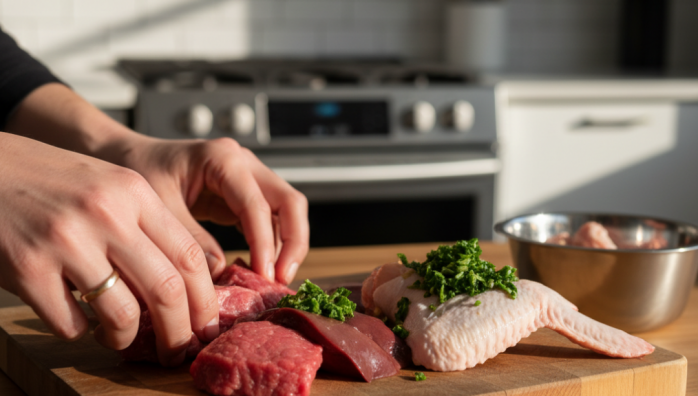Balancing BARF Diet Ingredients
by admin in Pet Care Basics 25 - Last Update November 20, 2025

When I first decided to switch my dog to a raw diet, the concept of \'Biologically Appropriate Raw Food\' (BARF) just clicked. It made perfect sense. But let me be honest, the practical side felt like a mountain to climb. The biggest hurdle? Balancing BARF diet ingredients. I spent weeks staring at spreadsheets and charts, completely overwhelmed and terrified of getting it wrong. It felt more like advanced chemistry than feeding my best friend.
Over the years, I\'ve learned that it\'s less about daily perfection and more about balance over time. If you\'re feeling that same sense of panic I did, I want to share the core principles that finally made it all make sense for me and my dogs.
The foundational BARF ratios I work with
The most common guideline you\'ll see is the 80/10/5/5 ratio. At first, I treated this like a rigid, scientific formula that had to be met with every single meal. That was my first mistake. Think of it more as a weekly or bi-weekly target. This is the general breakdown I aim for over time:
- 80% Muscle Meat: The main source of protein, amino acids, and energy.
- 10% Raw Edible Bone: Essential for calcium, phosphorus, and other minerals.
- 5% Liver: A powerhouse of vitamin A and other crucial nutrients.
- 5% Other Secreting Organs: Think kidney, spleen, pancreas, etc., which provide a different range of vitamins and minerals.
Muscle meat: the heart of the meal
This is the easy part. Muscle meat forms the bulk of the diet. The key lesson I learned here was the importance of variety. Sticking to just one protein, like chicken, can lead to nutritional gaps or even intolerances down the line. I make a point to rotate between at least three different proteins. Beef, turkey, lamb, and duck are all regulars in our rotation. This not only provides a broader spectrum of amino acids but also keeps mealtime exciting for my dog.
Raw meaty bones: for teeth and structure
I will openly admit this was the scariest component for me. The fear of choking was very real. I started with softer, fully edible bones like chicken wings and necks and I *always* supervise my dog while he\'s eating them. Never, ever feed cooked bones, as they become brittle and dangerous. The benefits, from clean teeth to providing a natural source of calcium and phosphorus, are incredible once you get comfortable with it. It’s a non-negotiable safety step to always watch them.
Organ meats: the superfood supplements
Organ meats are incredibly nutrient-dense, and you don\'t need much. Liver is non-negotiable for its vitamin A content, but too much can cause digestive upset—a lesson I learned the messy way. I started by introducing a tiny sliver and gradually worked up. The \'other secreting organs\' like kidney and spleen round out the nutrient profile. My pro-tip: I buy organs in bulk, portion them into tiny, meal-sized amounts in an ice cube tray, and freeze them. It makes daily prep so much easier.
What about fruits and vegetables?
This is a hot topic in the raw feeding community. Some purists believe they aren\'t necessary for carnivores. I\'ve found that a small amount of pureed, low-glycemic vegetables (like kale or broccoli stems) and dog-safe berries provides beneficial fiber and antioxidants. It\'s what works for my dog. If you choose to include them, ensure they are pureed to break down the cellulose, making them digestible for a dog. As with any new food, I recommend a quick chat with your vet to ensure your choices are safe and appropriate for your specific pet.
Ultimately, balancing a BARF diet became less of a chore when I started focusing on variety over time rather than perfect daily percentages. Watch your dog—their energy level, coat, and digestion are the best indicators you\'re on the right track.













